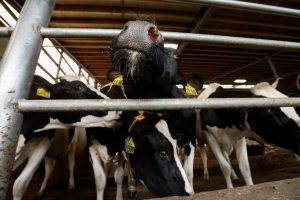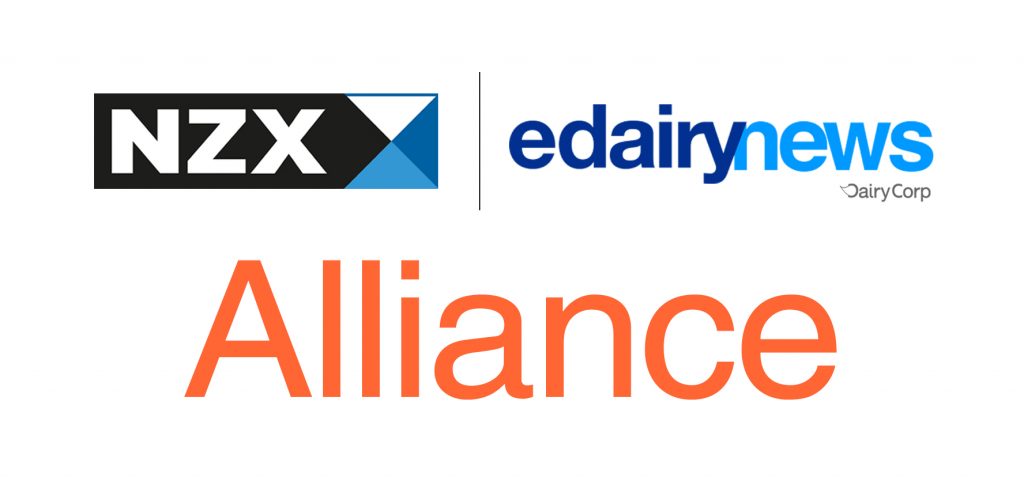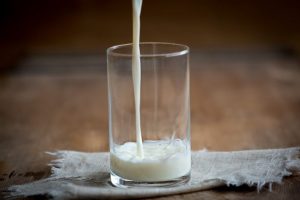Thankfully farm gate milk prices have stabilised. However the impact of weak dairy markets for most of the past 12 months has brought home, once again, the need for local milk producers to focus entirely on what they control within the confines of their own businesses.
A recent farm walk highlighted the steps that can be taken to secure optimal levels of efficiency, sustainability and carbon reduction within a robotic dairy farming operation.
The event was hosted by William and Alan McConnell, from Drumgaw in Co Armagh in association with the College of Agriculture, Food and Rural Enterprise (CAFRE).
The father and son team milk 135 cows using robots. William is still very active on the farm with Alan’s son James now taking on more of the herd management, although he is still at University.
The key take home messages delivered on the day relate to the reduction of waste, where animal management, in tandem with fertiliser and feed use are concerned.
The McConnell’s farm 88 hectares with a focus on milk production, replacement heifer and store cattle management.
The cows are totally housed, calving between August and March averaging. They are currently averaging 9,010 litres from 3.8t of concentrate fed per cow.
The feed efficiency figure across the herd is currently averaging 0.42kg/L. Milk from forage is coming at 574L/ cow at the present time.

Current milk from forage levels have seen a dip due to weather conditions in 2023. It is usually higher than this.
Courtesy of his presentation on the day, CAFRE senior dairy advisor, Alan Hopps, discussed the latest thinking on how best to drive sustainability within a modern dairy farming enterprise.
He confirmed the role of cow longevity within a milking group indetermining the number of replacement heifers needed within a dairying enterprise.
So, for example, lowering the average cull rate from 35% to 25% within a 120-strong milking group reduces the total number of heifers needed on the farm at any one time – assuming a 24-month first calving date – from 105 to 60 head. This included moving from 30 month to 24 month calving as well as reducing the age at calving.
In turn, this reduces the amount of land that must be dedicated to heifer rearing from 24.3 to 12.4ha.
“This represents a land saving of 11.9ha,” Alan Hopps commented.
“It also constitutes a cost saving as well as reducing the number of non milking stock on the farm.
“There are a number of steps that can be take to achieve a reduction in culling rate within a milking group.
“These include the use of good genetics with positives for lifespan and fertility.
“The attainment of high growth rate in heifers accompanied by 24-month first calving date is also important.”
He added:
“Early intervention in disease is important: remote animal monitoring can help in this regard.”
“All animals should be housed in good facilities that are not over-crowded.
“Good transition cow management standards, pre and post-calving, must be achieved.
“Vaccination protocols must be put in place and adhered to, as recommended by one’s veterinary surgeon
“Fertility management must include high heat detection and pregnancy rates, coupled with regular scanning and intervention for problem cows.”
William and Alan McConnell are currently calving their replacement heifers at an average of 25 months.
The heifers’ average weight at calving is 605kg. However, this figure rises to 650kg, at 150 days into milk.
Alan Hopps commented:
“These are well grown animals. It is also highly significant that they continue to put on weight so readily after calving.”
Where farm nutrient management standards are concerned, William and Alan have 53 fields tested under Northern Ireland’s Soil Nutrient Management Scheme (SNHS) A total of 17 fields have a pH value between 5.5 and 6.0 with 6 fields having a pH value greater than 6.5.
CAFRE Michael Verner discussed these matters at the event.
He commented:
“When it comes to making best use of slurries and fertiliser, all farmers should have their soils tested on a regular basis as part of a drive to reduce fertiliser wastage.
“Lime should be applied to improve efficiency of fertiliser use: target a pH of 6.5 for grass/clover swards
“In addition, a nutrient management plan should be completed for each field targeting slurry towards low phosphate and potash index soils
“Slurry should be applied using low emission spreading equipment. Where the application of fertiliser is concerned, protected urea products should be used, where possible.”
The rations fed to the milking group on the McConnell farm include a TMR comprising grass silage, whole crop rye and a purchased blend.
It is fed in the morning with additional feeding available in the robots at milking and courtesy and Cosmix out of parlour feeders.
The cows are fed to yield after 100 days: overall ration has a crude protein content 18%.
CAFRE’s Michael Garvey discussed the impct of the3 feeding strategies implementd on the McConnell farm.
He explained
“At 100 days feed-to-yield cows giving 24 litres gets 5½ kg of concentrates in the robot and 3½ kg in the wagon. There is a clear focus on reducing the levels of feed wastage on the farm
“Currently, a total 1.19t of concentrate is fed across the milking group on a daily basis feeding, based on a 10kg intake per cow, per day.”
Looking ahead, William and Alan McConnell will be looking at a number of options to improve feed efficiency. Securing higher levels of milk output from forage is one of these.
They will also be looking at alternatives to wholecrop rye while reducing the overall protein content of the rations on-offer to the cows is another priority for the future.
Meanwhile,there is also growing evidence to the effect that cross breeding can help drive efficiency within a modern dairy farming operation.
The specific benefits of ProCROSS breeding were discussed at a recent open day, hosted by Co Tyrone milk producer, Des Kelly. He farms close to the village of Ballygawley
The new entrant into milk imported 80 PROCross in-calf heifers from Denmark in three batches.
The first animals were milked by a Lely A5 robot at the beginning of 2023.
The ProCross has its origins in the United States 25 years ago. The cow type represents the result of a protracted breeding programme undertaken in that country under the aegis of Viking Genetics.
It brings together three breeds: Holstein, Montbéliarde and Viking Red.
This specific breed mix delivers for milk producers from a number of perspectives: sustainable milk yields, milk quality, longevity and fertility.
But by far the most significant benefit of ProCROSS cows is that of enhanced feed efficiency across a wide number of dietary options.
Viking Genetics’ Sven Johnsson spoke at the event.
He confirmed that ProCROSS cows can deliver up to a 33% improvement in lifetime profitability, relative to all other cow types.
He added:
“These results were confirmed courtesy of a 3,500 cow trial, carried out in Minnesota 10 years ago.
“Dairy farmers want to make money from their cows. Maximising feed efficiency is the way to achieve this. The US trial work has confirmed that ProCROSS stock can achieve this objective across a wide range of diets.
“ProCROSS cow numbers have increased significantly in a number of countries across Europe over the past number of years.
Significantly, Johnsson indicated that the cows are able to make maximum use of forages.
“This makes them very suited to the grazed grass and grass silage – based systems that predominate in Ireland.
Des Kelly explained that two fundamentally important decisions were made when the4 initial decision to get into milk production was made.
He added:
. The first was to commit to an established cross-breeding programme, where the cows are concerned: the other was to invest in a robotic milking system.
“I am happy to confirm that both decisions were the correct ones to take.
At the heart of the ProCROSS breeding programme is the sequential use of Holstein, Montbéliarde and Danish Red genetics.
Des Kelly again:
“All the animals were imported from Denmark as in-calf heifers in three batches,” Des further explained.
“The breeding history of each animal was confirmed, going back over a number of generations.
“As a result, the position of each in the ProCROSS breeding cycle can be clearly identified.
“This allows me to select the specific breed of sire to be used on each animal in order to maintain the full impact of ProCROSS programme across the next and future generations of cows on the farm.”
The animals currently on the robot are averaging 32.3L per day at 4.27% butterfat and 3.35% protein.
The open day was jointly hosted by Ai Services (Northern Ireland) Ltd.
Company breeding manager, Ivan Minford, commented:
“There is a growing demand for medium-sized cross bred cows that will deliver significvant volumes of high quality milk over a long number of lactations.
“The ProCROSS option meets this requirement in a more than meaningful way.”
One of the most insightful commentaries of the day was provided by Lely’s Tommy Johnston.
He confirmed that the animals coming into the robot while the event was taking place were recording an average milking speed of 3kg/minute, adding.
“The average figure for Northern Ireland is 2½kg. This faster milking speed is the reason why a single robot can cope with 65 plus cows within the same group.”
The growing footprint of robotic milking systems within Northern Ireland’s dairy sector isobvious.
At Drayne’s Farm on the outskirts of Lisburn, 120 Holstein cows are milked robotically. Here milking speed is a critical factor within the business.
So much so that replacement heifers are now bred with improved milking speed potential very much a priority.
Drayne’s farm manager, Chris Wright explained.
“Our average milking speed is currently 1.9L/minute. The scope to bring this figure up 2.9L exists. We have identified the group of animals within the herd that are slow milkers.
“The plan is to breed their bloodlines out of the milking group and replace these with young stock that are genetically programmed to milk faster within a robotic system.
“By taking this approach we should also be able to significantly improve the number of cows being milked on the farm the year-round.”
Currently two of the robots are set up as total confinement system. However, a third has been configured to allow in-calf cows out to graze during the spring and summer months.
One of the robots is dedicated to freshly calved heifers only.
You can now read the most important #news on #eDairyNews #Whatsapp channels!!!
🇺🇸 eDairy News INGLÊS: https://whatsapp.com/channel/0029VaKsjzGDTkJyIN6hcP1K
















